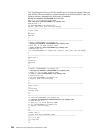
If the recommended connection between two systems is actually an SMTP
connection instead of a SNADS connection, you can still use the *ANY entry by
adding an SMTP address to it. The SMTP user ID is left blank and the SMTP
domain is filled in with the host.domain information for SYSTEMA, for example:
SYSTEMA.MYTOWN.MYCOMPANY.COM
To tell OS/400 to use SMTP instead of SNADS to deliver mail between the two
systems, set the
Mail service level
to 2 (System message store) and set
Preferred
address
to 3 (SMTP name).
For more information on *ANY support, see
SNA Distribution Services
,
SC41-5410-01 .
A Client Access-based POP mail user can also send mail to an OS/400 distribution
list.
MIME Mail Sent To OfficeVision
When a POP client sends mail to another POP client, the note is delivered without
any conversions or transformations. The content of a POP-to-POP message is not
affected by the POP server.
When mail is sent from POP to OfficeVision clients, the MIME parser snap-in
converts MIME notes to OfficeVision/400 notes and documents. The snap-in
converts any MIME text attachments into a single OfficeVision note and converts
any binary attachments into documents with a type of IBM Personal Computer file.
References to the binary attachments are noted in the OfficeVision Text Note in the
same order in which they were encountered in the original MIME note.
While OfficeVision/400 is not MIME-compliant, the MIME conversion that occurs in
the mail server framework allows users to view the text portions of MIME notes. To
control the size and margins of lines so that lines do not appear truncated when
viewed in OfficeVision/400, see “Long Line Conversion” on page 299, later in this
section. OfficeVision users may also be able to view the binary portions of the
MIME notes if they are using a graphical user interface such as IBM
Current-OfficeVision/400. With this interface you can download the documents and
start a handler to process the file. The extension of the file name determines which
handler is called.
The POP server also preserves the original MIME type and subtype of the binary
attachment. It tries to derive the file name of the original document. This is useful
because many mail clients use the extension of the document as a means of
“typing” the file and starting the proper handler for that attachment when the icon for
the attachment is clicked. This derived file name is also used as the Subject after it
has been enclosed by parentheses. The graphical OfficeVision interface called
Current-OfficeVision/400 uses the file name to name downloaded files for
processing at the workstation level.
Because OfficeVision is not MIME-compliant, no attachment icons are displayed
and OfficeVision does
not
attempt to process the binary documents. If you try to
view these documents from the mail menu of OfficeVision, OfficeVision displays a
message saying that the document cannot be viewed. The binary attachments can
be forwarded to MIME-compliant mail users who can display them. They can also
be copied to local folders and accessed by using AS/400 Client Access network
drives.
298 OS/400 TCP/IP Configuration and Reference V4R4


















